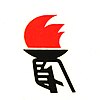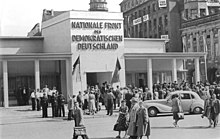| National Front of the German Democratic Republic Nationale Front der Deutschen Demokratischen Republik | |
|---|---|
| Chairman | Erich Correns (1950–1981) Lothar Kolditz (1981–1990) |
| Founded | 30 March 1950 |
| Dissolved | 20 February 1990 |
| Preceded by | Democratic Bloc |
| Headquarters | East Berlin, German Democratic Republic |
| Ideology |
|
| Political position | Far-left |
The National Front of the German Democratic Republic (German: Nationale Front der Deutschen Demokratischen Republik) was officially an alliance of parties and mass organisations (1950–1990). In fact, only one party held power in the GDR, namely the communist SED. The National Front was an instrument to exercise control over the other parties and organisations. The precursor of the National Front was the Democratic Bloc (since 1945).
The main task of the National Front was to draw up a common electoral list ("Einheitsliste") in elections to the East German parliament, the Volkskammer ("People's Chamber"). This "unity list" was the only list that citizens could vote for. Other parties or lists were prohibited. The National Front system was intended to give to the outside world the impression that there was a democracy with a multi-party system in the GDR.
After the Second World War, the Allies initially allowed four parties: the Communists, the Social Democrats, the Christian Democratic Union and the Liberal Democratic Party. In the Soviet Occupation Zone, the Communist Party forced the Social Democrats to merge (1946). Thus the communist-dominated Socialist Unity Party (SED) was formed.
The other two parties, the Christian Democratic Union and the Liberal Democratic Party, were initially independent. The SED, with the help of the Soviet occupation authorities, intimidated these parties, removed and sometimes deported their leaders and forced them to get on course. Finally, the occupying authorities allowed two new parties to be founded: the Democratic Farmers' Party (DBD) and the National Democratic Party (NDPD) (1948). Both parties were founded by the SED, their first leaders even being former SED and Communist party functionaries respectively. Their task was to poach voters from the Christian Democrats and Liberals. The National Democrats were also supposed to be a collecting ground for former National Socialists. The parties that were not the SED were called Blockpartei.
Finally, there were so-called mass organisations in the Soviet occupation zone and then in the GDR. Some of them were represented on the electoral list, such as the trade union and the women's organisation. Nearly all of these MPs were members of the SED. Therefore, although the SED faction in parliament did not have an absolute majority, most MPs were nevertheless SED members.
All parties and mass organisations in the National Front had to officially accept the SED's leading role as a condition of their existence. The SED had significant control over these parties, with their leadership even at a regional level being subject to approval by the Friendly Parties Department of the SED Central Committee. The parties were afforded a large amount of infrastructure, including party buildings, newspapers and companies and were represented in the East German government by several ministers each, though as all ministers, they were de jure bound to directives issued by their responsible Central Committee Secretary. Only in the last weeks prior to the fall of the Berlin Wall (November 1989), some politicians of non-SED parties started to moderately criticize SED dominance. The Front disbanded in February 1990, a month before the first free elections in the GDR.
The Liberal Democratic Party and National Democratic Party eventually merged with the West German Free Democratic Party, whereas the Christian Democratic Union and the Democratic Farmers' Party merged with the West German Christian Democratic Union. This saw controversy at the time because the elaborate infrastructure that the SED had afforded the bloc parties put them at a great competitive advantage over newly established parties.
Constituent parties
| Party | Emblem | Flag | Foundation | Dissolution | Seats in the Volkskammer (1986) |
|---|---|---|---|---|---|
| Socialist Unity Party SED |
 |
 |
21 April 1946 | 16 December 1989 | 127 |
| Christian Democratic Union CDU |
[REDACTED] |  |
26 June 1945 | 1/2 October 1990 | 52 |
| Liberal Democratic Party LDPD |
[REDACTED] |  |
5 July 1945 | 27 March 1990 | 52 |
| Democratic Farmers' Party DBD |
[REDACTED] |  |
17 June 1948 | 15 September 1990 | 52 |
| National Democratic Party NDPD |
 |
 |
5 May 1948 | 27 March 1990 | 52 |
Constituent mass organizations represented in the People's Chamber

| Organization | Emblem | Flag | Foundation | Dissolution | Assigned representatives in the Volkskammer (1986) |
|---|---|---|---|---|---|
| Free German Trade Union Federation FDGB |
 |
 |
1946 | 1990 | 61 |
| Free German Youth FDJ |
 |
 |
1946 | exists today | 37 |
| Democratic Women's League of Germany DFD |
 |
1947 | 1990 | 32 | |
| Cultural Association of the DDR KB |
 |
 |
1945 | 1990 | 21 |
| Peasants Mutual Aid Association VdgB |
[REDACTED] |  |
1945 | 1994 | 14 |
Other organizations associated with the National Front
The following organizations, which were part of the NF, did not send elected representatives to the Volkskammer but were active in the performance of its activities.
| Organization | Emblem | Foundation | Dissolution |
|---|---|---|---|
| Society for German–Soviet Friendship | [REDACTED] | 1949 | 1992 |
| People's Solidarity |  |
1945 | exists today |
| Sport and Technology Association |  |
1952 | 1990 |
| German Gymnastics and Sports Federation |  |
1957 | 1990 |
| Ernst Thälmann Pioneer Organisation |  |
1948 | 1990 |
| Writers' Association of the GDR | [REDACTED] | 1945 | 1990 |
| Association of Gardeners, Settlers, and Animal Breeders | [REDACTED] | 1952 | 1990 |
| Association of Theatre Professionals [de] |  |
1966 | 1990 |
| Union of Journalists |  |
1945 | 1990 |
| Chamber of Engineering [de] | [REDACTED] | 1946 | 1990 |
| Peace Council of the GDR [de] |  |
1949 | 1990 |
| Union of Persecutees of the Nazi Regime |  |
1947 | banned in East Germany in 1953, exists today |
| Association of German Consumer Cooperatives |  |
1949 | exists today (Zentralkonsum eG) |
| German Red Cross of the GDR |  |
1952 | 1991 |
| Committee of Antifascist Resistance Fighters | [REDACTED] | 1953 | 1991 |
| Solidarity Committee of the GDR |  |
1960 | 1990 |
| League of Lusatian Sorbs |  |
1912 founded before the creation of the GDR |
exists today |
History


The National Front was the successor to the Demokratischer Block which had been founded in the Soviet occupation zone. The Front itself was founded on 30 March 1950. It operated through the issuing of a generally consistent proportion of seats (divided between the Front's parties and SED-controlled mass organisations) submitted in the form of a single list of candidates during each election to the People's Chamber. Seats were awarded on the basis of a set quota rather than vote totals. As voters only had the option of approving or rejecting the list in far-from-secret conditions, it "won" with virtually unanimous levels of support.
Although nominally a broad-based coalition of parties, in practice the SED was the only one with any real power. By ensuring that Communists dominated the lists, the SED essentially predetermined the composition of the People's Chamber.
In 1950-1951, the public rejection of the validity of the list by some German politicians resulted in some of them being imprisoned for "rejecting the electoral law of the German Democratic Republic" (as in the case of LDPD leader Günter Stempel). Although the SED had already become a full-fledged Stalinist "party of the new type" by the formation of the GDR, the other parties did not completely bend to the SED's will for a time. By the mid-1950s, however, the more courageous members of the constituent parties had been pushed out, and the parties had all been transformed into loyal partners of the SED. By this time, the SED itself had purged its few independent-minded members as well. The Front now took on a character similar to other groupings in the Eastern Bloc. For the next three decades, the minor parties in the Front had to accept the SED's "leading role" as a condition of their continued existence.
On 1 December 1989, the Front was effectively rendered impotent when the Volkskammer deleted the provision of the Constitution of East Germany that gave the SED a monopoly of power. Four days later, the Christian Democratic Union and Liberal Democratic Party, having thrown out their pro-Communist leaderships, withdrew from the Front. On 16 December the SED, having transformed itself into a democratic socialist party, reformed itself into the Party of Democratic Socialism. On 20 February 1990, an amendment to the constitution removed mention of the Front.
Chairmen of the National Front
The National Front, as in institution, was led by a National Council that included representatives from all of its constituent organisations, with the SED being over-represented. The National Council elected a Presidium, whose chairman always was an independent politician. Despite the NF's power on paper, the chairman had almost no influence.
- Prof. Erich Correns (1950–1981)
- Prof. Lothar Kolditz (1981–1989)
Electoral history
Volkskammer elections
| Election | Votes | % | Seats | +/– | Position | Government |
|---|---|---|---|---|---|---|
| 1950 | 12,088,745 | 99.6% | 466 / 466 | Sole legal coalition | ||
| 1954 | 11,828,877 | 99.46% | 466 / 466 | Sole legal coalition | ||
| 1958 | 11,689,110 | 99.87% | 466 / 466 | Sole legal coalition | ||
| 1963 | 11,533,859 | 99.25% | 434 / 434 | Sole legal coalition | ||
| 1967 | 11,197,265 | 99.93% | 434 / 434 | Sole legal coalition | ||
| 1971 | 11,207,388 | 99.5% | 434 / 434 | Sole legal coalition | ||
| 1976 | 11,245,023 | 98.58% | 434 / 434 | Sole legal coalition | ||
| 1981 | 12,235,515 | 99.9% | 500 / 500 | Sole legal coalition | ||
| 1986 | 12,392,094 | 99.94% | 500 / 500 | Sole legal coalition |
See also
- Politics of East Germany
- List of Volkskammer members (9th election period)
- Vietnamese Fatherland Front
- Democratic Front for the Reunification of the Fatherland
- Polish Committee of National Liberation/Front of National Unity
- National Front
- Fatherland Front
- People's Democratic Front/Front of Socialist Unity and Democracy
- Lao Front for National Construction
- National United Front of Kampuchea
References
- Andreas Malchya: Der Ausbau des neuen Systems 1949 bis 1961, Bundeszentrale für politische Bildung, last retrieved 2019-05-01.
- "Aufruf der Liberal-Demokratischen Partei Deutschlands an das deutsche Volk vom 5. Juli 1945" (PDF) (in German). Archived from the original (PDF; 1,0 MB) on 2018-10-25. Retrieved 2017-10-20. Digitalisat des Archivs des Liberalismus
- "DDR-Lexikon: NDPD". www.ddr-wissen.de.
- "Domains – Iportale".
- Eugene Register-Guard October 29, 1989. p. 5A.
- Kurt Sontheimer & Wilhelm Bleek. The Government and Politics of East Germany. New York: St. Martin's Press. 1975. p. 66.
- Peter E. Quint. The Imperfect Union: Constitutional Structures of German Unification. Princeton, N.J.: Princeton University Press. 1997. p. 37.
External links
| Organizations of the German Democratic Republic | |
|---|---|
| Mass organizations with representation in the Volkskammer |
|
| Other organizations within the National Front |
|
